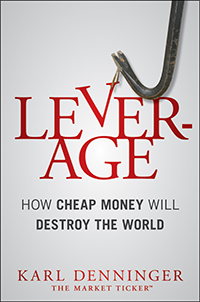.... is reversing. Finally.
In fact it can be argued that it was precisely the day in September when The Fed announced its "50 point cut" that marked the turn. The astonishing part of that is the fact that while the 13 week bill had been on a general downward yield trend since July the 10 year in fact was the primary turn at the announcement.
No matter; it is basically flat right now, coming into the next announcement this week.
There is, of course, this little thing happening tomorrow.
But the inflationary impulse that was put into the system with that "cut" befell the general problem with this sort of game: You can control system liquidity, but your ability to control where it goes is much more-limited. Specifically what hasn't happened is material improvement in home affordability, and while the market has gone up a bit its more like gasping for air as it flails in the water at present and worse, there's a non-confirmation in the Nasdaq which topped in early July -- and the Russell hasn't made new highs either.
Nobody, of course, ever pays attention to that sort of thing, but you certainly should. Thin markets, where leadership is not followed on, are dangerous. Add on to that higher and higher margin debt levels and you've got a warning.
Now consider that rate environments tend to be multi-decade -- 20 or 30 year, sometimes as much as 50 year -- cycles. They typically are not only a few years in duration and in fact it certainly would appear that the last one, from 1980 to 2020, has reversed.
In a generally-declining rate environment financing becomes progressively easier and rolling over debt becomes cheaper with time. This in turn encourages increasing the leverage in your business and the system as a whole. But when that reverses, and it certainly appears it has, then debt becomes more expensive with time and in many cases rolling over debt is not just more expensive -- it can't be afforded at all.
The implied difference in return from business between being able to take a 5% interest rate for $1 million (costing you $50,000 a year) and roll it over for 3% (costing you $30,000 a year), thereby adding $20,000 to your net and the reverse where that same rollover now subtracts $20,000 from your net is profound and the more leverage you have on the worse the impact.
Four decades of people figuring out what is a "reasonable" forward P/E when the refinancing is always to the benefit of cash flow and then when that trend reverses suddenly the refinancing is equally negative to cash flow is bound to have an impact on what someone thinks they should pay on a forward basis in the markets -- whether the thing being bought is stock or anything else, like, for instance, a house.
In the time period from 2010ish to around 2018 it was obvious the cycle was ending. Again, these are long-term -- multi-decade -- cycles. But has the corporate world responded by taking down their debt levels?
That's a "no." 
So what is inevitably going to happen when that huge pile of debt has to roll over during the next few years when it comes to corporate profitability -- or even survivability?
You could forgive people for not paying much attention to this -- after all how many professionals do you know who were in the markets in any way in 1980, right around the time the last cycle turned? I was just coming of age at that time; I had no knowledge of the impact of the former cycle when it came to borrowing and taking on leverage (foolish during that period, and if you tried it you usually got bankrupted) yet essentially everyone in the business world today was not around for enough of the former cycle to understand it because you'd have to be well into your retirement years to have experienced it.
Who is in the game and old enough to have had a decent amount of experience with the previous cycle?
Warren Buffett -- and he's sitting on over $300 billion in cash right now, having been quietly selling down Berkshire's portfolio. To put a not-so-fine line on it roughly a third of Berkshire is sitting in cash, a record, and if this rate pattern is anything like those in history generally higher rates are in the forecast for the next three decades, not the next couple of years.


